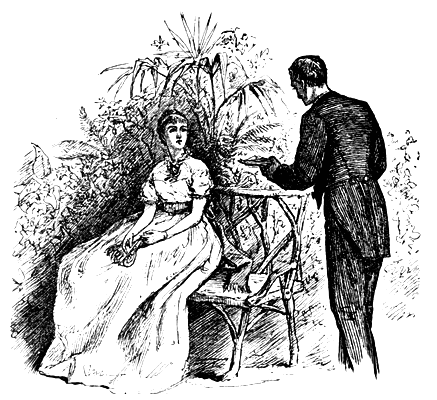 |
| Meg at the ball, from "Meg Goes to Vanity Fair" |
Waltz (3/4)
"She leaned her forehead on the cool pane, and stood half hidden by the curtains, never minding that her favorite waltz had begun, till some one touched her; and, turning, she saw Laurie, looking penitent, as he said, with his very best bow, and his hand out. ...Away they went, fleetly and gracefully; for, having practiced at home, they were well matched, and the blithe young couple were a pleasant sight to see, as they twirled merrily round and round, feeling more friendly than ever after their small tiff."-Meg Goes to Vanity Fair
By the 1860s, the waltz had already been present in American ballrooms for several decades (although with some evolution over time). I think the waltz is especially interesting as the choice here because of its history: originally making its way from Europe to England in the early 1800s, the waltz was unique from most English dances of the time as it was done in a close hold between partners (which gave it a somewhat questionable reputation!). By the mid-1810s the waltz had taken off, and was popular as a fashionable dance. Wilson, a dance master of the time who wrote extensively about popular dances, published A description of the correct methods of waltzing in 1816. In it he describes:
"Waltzing, since its origin, has ever been a particularly favorite amusement in the higher circles of fashion...It is rather unfortunate that introduction of waltzing should have been so much objected to." (emphasis Wilson.)
This choreography of 3 waltzes comes from that publication--it begins with basic waltz until about 0:18.
In early waltz, the dancers stay on their toes throughout the six steps (each taken on one count of the music). Mid-century waltz actually uses the same series of six steps, but the dancers move up and down between the balls and flat of their feet so that the dance has a rise and fall that is reminiscent of a carousel horse.
The hold had also changed by the mid-century, standardizing from the variety of options available in the 1810s (Wilson shows 9 in his book) to a single "waltz hold" by Howe's 1858 manual. Howe describes correct waltz position as relaxed and rounded:
"The gentlemen should place himself directly opposite his lady, upright, but without stiffness; joining hands, the left arm of the gentleman should be rounded with the right arm of the lady, so as to form an are of a circle, supple and elastic."
You can get a feel for the natural rise and fall of 1860s waltz in the video below. Notice the up and down of each couple as the step, and also that the main contact of the hold is really in the gentleman's arm on the lady's waist, with the other hands forming a circle (as described by Howe).
As I mentioned above, I think waltz pairs neatly with redowa in Meg's part scenes to show the contrast of the events she's attending. Where redowa was a newer dance, part of the Bohemian fad and still maintaining a lively "country" spirit, the waltz was old by the 1860s--a refined and standardized classic. In fact, by the 1850s waltzing was such a classic that Durang notes in his 1856 manual that "in this age of waltzing, we need not dilate at length" on the basics of it. He then proceeds to describe the step under the heading "The Old Waltz, Called with Us the Plain One." Even though both are danced in the same time signature, waltz feels elegant and measured, and it's easy to imagine it being done in European palaces. To me, this fits the atmosphere of the Moffats' party rather well, as it's a gathering of Boston wealthy society--bringing with it elegance, ill gossip, and significant contrast to Concord that leaves Meg valuing the way things are at home.
I'll end on one final video. In addition to appearing as a dance in its own right, waltz steps appeared in "figured waltzes" (contra dances in waltz time that included figures as well as waltzing) during this period. This demonstrates a key skill for couple dances (including but not limited to waltz): steering! Whether navigating a crowded ballroom floor or moving in specific patterns with in a figured waltz, being able to steer effectively was an important part of learning the dance. Durang (1856) even mentions this explicitly:
"considerable practice [is required] on the gentleman's part to dance it well; for he, especially, has to guide the lady through the mass of confused waltzing couples into which it usually forms itself: and herein lies the skill of the gentleman waltzer, sustained by the easy dexterity of his partner—it is to preserve the step and time and perform the various evolutions in gracefully avoiding collisions with the other couples in whirling by them, or, in threading gently through the “cretan labyrinth” of the modern waltzing ballroom."
So with that, here is a short clip of a figured waltz called "Spanish waltz" from Howe (1862), ending with plain waltz around the ballroom.
Next time, we head to Europe with Amy!

No comments:
Post a Comment